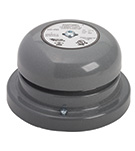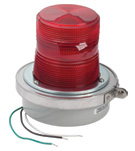Fire Alarm Systems
Having an early fire warning system can significantly reduce injuries, loss of life, and property damage. Smoke alarms alert residents, guests, patients, and staff to potential danger so they can safely evacuate the building. Follow the fire safety guidelines and recommendations for your property.

Types of Fire Alarm Systems
Automatic fire and smoke detection are a critical part of every facility's fire preparedness and safety. There are several types of fire alarm systems available. Learn the differences and functionality of each to make sure you have the right ones for every area and application.
Smoke Alarms

Many state and local laws require smoke alarms be installed in commercial, residential, and multifamily properties. Find Your State's Smoke Alarm Requirements
Smoke alarms are available in two types – ionization and photoelectric.
Ionization smoke alarms are best at detecting fast-flaming fires from paper or wood. Learn More About Ionization Alarms
Photoelectric smoke alarms respond better to slow smoldering fires caused by flammable liquids, paint, cleaning chemicals, etc. Learn More About Photoelectric Alarms
Dual sensing smoke alarms feature both ionization and photoelectric technologies that detect both fast-flaming fires and smoke from smoldering fires. Shop Dual Sensing Smoke Alarms
Since no one can cannot predict what type of fire will occur, the National Fire Prevention Association (NFPA) recommends installing both ionization and photoelectric alarms to maximize protection.
Shop All Smoke AlarmsConventional Pull Alarms

Sometimes, fire and smoke are seen and smelled by residents, guests, and staff before alarms are activated. Used in conjunction with automatic alarms, manual pull station alarms are an effective early warning system. When adding or replacing pull alarms, follow your building code requirements and make sure the alarms are easily accessible and mounted at the proper height for ADA compliance.
Shop Conventional Pull AlarmsBells, Horns & Sirens

One of the oldest methods of fire alert are high performance bells, horns, and sirens. They deliver loud signals to warn anyone at risk. These devices are ideal for schools, warehouses, factories, machine shops, building exteriors, and other areas where it may be hard to hear a regular fire alarm.
Shop Bells, Horns & SirensFlashing Beacons

Flashing beacons visually alert the hearing impaired and those who work in a high-noise environment that a fire is active.
Shop Flashing BeaconsFire Alarm Testing & Maintenance

When working properly, smoke alarms help save lives. Performing regular testing and routine alarm maintenance also keeps you in compliance with state/local fire inspectors and your insurance carrier.
During your inspection:
- Look for signs of tampering or disabling
- Install fresh batteries
- Ensure alarm is audible
- Remove any obstructions that may affect performance
Fire alarm testing regulations and fire alarm maintenance vary by state. Always check with your local government for the most current testing requirements.
According to the National Fire Alarm Code (NFPA 72), pull station alarms should be tested annually. For a code-compliant test, you must make sure the pull handle mechanism operates properly and that the station initiates an alarm at the fire control unit.
When to Replace Fire Alarms
According to the National Fire Protection Association (NFPA), smoke alarms should be replaced according to the manufacturer's recommendations, or when they do not respond properly when tested.
